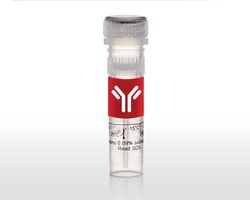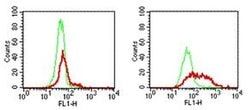50-137-88
CD284 (TLR4) Monoclonal Antibody (UT41), eBioscience™, Invitrogen™
Manufacturer: Fischer Scientific
Select a Size
| Pack Size | SKU | Availability | Price |
|---|---|---|---|
| Each of 1 | 50-137-88-Each-of-1 | In Stock | ₹ 10,235.00 |
50-137-88 - Each of 1
In Stock
Quantity
1
Base Price: ₹ 10,235.00
GST (18%): ₹ 1,842.30
Total Price: ₹ 12,077.30
Antigen
CD284 (TLR4)
Classification
Monoclonal
Concentration
0.5 mg/mL
Formulation
PBS with 0.09% sodium azide; pH 7.2
Gene Accession No.
Q9QUK6
Gene Symbols
TLR4
Purification Method
Affinity chromatography
Regulatory Status
RUO
Gene ID (Entrez)
21898
Content And Storage
4° C
Form
Liquid
Applications
Flow Cytometry
Clone
UT41
Conjugate
Unconjugated
Gene
TLR4
Gene Alias
ARMD10; CD284; EGK_07381; homolog of Drosophila toll; hToll; lipopolysaccharide response; Lps; Ly87; Ran/M1; Rasl2-8; Tlr4; TLR-4; TOLL; toll like receptor 4; toll/interleukin-l receptor (TIR) domain; toll4; toll-like receptor 4; toll-like receptor 4 immunity-related protein; Toll-like receptor 4-like protein; Toll-like receptor4 protein
Host Species
Mouse
Quantity
25 μg
Primary or Secondary
Primary
Target Species
Mouse
Product Type
Antibody
Isotype
IgG1 κ
Description
- Description: The UT41 monoclonal antibody was generated against BaF3 cells overexpressing mouse TLR4
- So far, at least twelve members of the Toll family have been identified
- This family of type I transmembrane protein is characterized by an extracellular domain with leucine-rich repeats and a cytoplasmic domain with homology to the type I IL-1 receptor
- Two of these receptors, TLR2 and TLR4, are pattern recognition receptors and signaling molecules in response to bacterial lipoproteins and have been implicated in innate immunity and inflammation
- TLR4 physically associates with another molecule called MD-2, and together with CD14, this complex is responsible for LPS recognition and signaling
- TLR4, which is approximately 100 kDa, is expressed by myeloid lineage cells
- The MTS510 monoclonal antibody co-immunoprecipitates MD-2 (∽30 kDa) and TLR4 (∽100 kDa), and preferentially reacts with TLR4 that is associated with MD-2
- In comparison, binding of the UT41 monoclonal antibody occurs with and without formation of the TLR4/MD-2 complex
- Please contact eBioscience Technical Support for further information
- Applications Reported: This UT41 antibody has been reported for use in flow cytometric analysis
- Applications Tested: This UT41 antibody has been tested by flow cytometric analysis of mouse thioglycolate-elicited peritoneal exudate cells
- This can be used at less than or equal to 0.5 μg per test
- TLR4 is member of the Toll like receptor (TLR) family which plays a fundamental role in pathogen recognition and activation of innate immunity
- TLRs are highly conserved from Drosophila to humans and share structural and functional similarities
- This receptor is most abundantly expressed in placenta, and in myelomonocytic subpopulation of the leukocytes
- Mammalian cells respond to LPS by activating TLR4
- TLR4 belongs to the multi-protein complex of lipopolysaccharide (LPS) receptor, containing CD14, LY96 and TLR4, and is involved in signal transduction events induced by lipopolysaccharide (LPS) found in most gram-negative bacteria
- TLR4 aids in the recognition of pathogen-associated molecular patterns (PAMPs) that are expressed on infectious agents, and mediate the production of cytokines necessary for the development of effective immunity
- The various TLRs exhibit different patterns of expression
- Mutations in the TLR4 gene have been associated with differences in LPS responsiveness
- Also, several transcript variants of the TLR4 gene have been found, but the protein coding potential of most of them is uncertain
- TLR4 is expressed by peripheral blood monocytes and a small population of B-cells and is also expressed in human placenta
- Studies with TLR4-deficient mice indicate that the main ligand for TLR is lipopolysaccharide
- Consequently, these mice also showed increased susceptibility to Gram-negative sepsis.
Compare Similar Items
Show Difference
Antigen: CD284 (TLR4)
Classification: Monoclonal
Concentration: 0.5 mg/mL
Formulation: PBS with 0.09% sodium azide; pH 7.2
Gene Accession No.: Q9QUK6
Gene Symbols: TLR4
Purification Method: Affinity chromatography
Regulatory Status: RUO
Gene ID (Entrez): 21898
Content And Storage: 4° C
Form: Liquid
Applications: Flow Cytometry
Clone: UT41
Conjugate: Unconjugated
Gene: TLR4
Gene Alias: ARMD10; CD284; EGK_07381; homolog of Drosophila toll; hToll; lipopolysaccharide response; Lps; Ly87; Ran/M1; Rasl2-8; Tlr4; TLR-4; TOLL; toll like receptor 4; toll/interleukin-l receptor (TIR) domain; toll4; toll-like receptor 4; toll-like receptor 4 immunity-related protein; Toll-like receptor 4-like protein; Toll-like receptor4 protein
Host Species: Mouse
Quantity: 25 μg
Primary or Secondary: Primary
Target Species: Mouse
Product Type: Antibody
Isotype: IgG1 κ
Antigen:
CD284 (TLR4)
Classification:
Monoclonal
Concentration:
0.5 mg/mL
Formulation:
PBS with 0.09% sodium azide; pH 7.2
Gene Accession No.:
Q9QUK6
Gene Symbols:
TLR4
Purification Method:
Affinity chromatography
Regulatory Status:
RUO
Gene ID (Entrez):
21898
Content And Storage:
4° C
Form:
Liquid
Applications:
Flow Cytometry
Clone:
UT41
Conjugate:
Unconjugated
Gene:
TLR4
Gene Alias:
ARMD10; CD284; EGK_07381; homolog of Drosophila toll; hToll; lipopolysaccharide response; Lps; Ly87; Ran/M1; Rasl2-8; Tlr4; TLR-4; TOLL; toll like receptor 4; toll/interleukin-l receptor (TIR) domain; toll4; toll-like receptor 4; toll-like receptor 4 immunity-related protein; Toll-like receptor 4-like protein; Toll-like receptor4 protein
Host Species:
Mouse
Quantity:
25 μg
Primary or Secondary:
Primary
Target Species:
Mouse
Product Type:
Antibody
Isotype:
IgG1 κ
Antigen: __
Classification: __
Concentration: __
Formulation: __
Gene Accession No.: __
Gene Symbols: __
Purification Method: __
Regulatory Status: __
Gene ID (Entrez): __
Content And Storage: __
Form: __
Applications: __
Clone: __
Conjugate: __
Gene: __
Gene Alias: __
Host Species: __
Quantity: __
Primary or Secondary: __
Target Species: __
Product Type: __
Isotype: __
Antigen:
__
Classification:
__
Concentration:
__
Formulation:
__
Gene Accession No.:
__
Gene Symbols:
__
Purification Method:
__
Regulatory Status:
__
Gene ID (Entrez):
__
Content And Storage:
__
Form:
__
Applications:
__
Clone:
__
Conjugate:
__
Gene:
__
Gene Alias:
__
Host Species:
__
Quantity:
__
Primary or Secondary:
__
Target Species:
__
Product Type:
__
Isotype:
__
Antigen: __
Classification: __
Concentration: __
Formulation: __
Gene Accession No.: __
Gene Symbols: __
Purification Method: __
Regulatory Status: __
Gene ID (Entrez): __
Content And Storage: __
Form: __
Applications: __
Clone: __
Conjugate: __
Gene: __
Gene Alias: __
Host Species: __
Quantity: __
Primary or Secondary: __
Target Species: __
Product Type: __
Isotype: __
Antigen:
__
Classification:
__
Concentration:
__
Formulation:
__
Gene Accession No.:
__
Gene Symbols:
__
Purification Method:
__
Regulatory Status:
__
Gene ID (Entrez):
__
Content And Storage:
__
Form:
__
Applications:
__
Clone:
__
Conjugate:
__
Gene:
__
Gene Alias:
__
Host Species:
__
Quantity:
__
Primary or Secondary:
__
Target Species:
__
Product Type:
__
Isotype:
__
Antigen: CD289 (TLR9)
Classification: Monoclonal
Concentration: 0.5 mg/mL
Formulation: PBS with 0.09% sodium azide; pH 7.2
Gene Accession No.: Q9NR96
Gene Symbols: Tlr9
Purification Method: Affinity chromatography
Regulatory Status: RUO
Gene ID (Entrez): 54106
Content And Storage: 4° C
Form: Liquid
Applications: Flow Cytometry, Immunohistochemistry (Paraffin), Immunoprecipitation, Western Blot
Clone: eB72-1665
Conjugate: Unconjugated
Gene: Tlr9
Gene Alias: CD289; Tlr9; toll like receptor 9; toll-like receptor 9; UNQ5798/PRO19605
Host Species: Rat
Quantity: 100 μg
Primary or Secondary: Primary
Target Species: Human
Product Type: Antibody
Isotype: IgG2a κ
Antigen:
CD289 (TLR9)
Classification:
Monoclonal
Concentration:
0.5 mg/mL
Formulation:
PBS with 0.09% sodium azide; pH 7.2
Gene Accession No.:
Q9NR96
Gene Symbols:
Tlr9
Purification Method:
Affinity chromatography
Regulatory Status:
RUO
Gene ID (Entrez):
54106
Content And Storage:
4° C
Form:
Liquid
Applications:
Flow Cytometry, Immunohistochemistry (Paraffin), Immunoprecipitation, Western Blot
Clone:
eB72-1665
Conjugate:
Unconjugated
Gene:
Tlr9
Gene Alias:
CD289; Tlr9; toll like receptor 9; toll-like receptor 9; UNQ5798/PRO19605
Host Species:
Rat
Quantity:
100 μg
Primary or Secondary:
Primary
Target Species:
Human
Product Type:
Antibody
Isotype:
IgG2a κ


